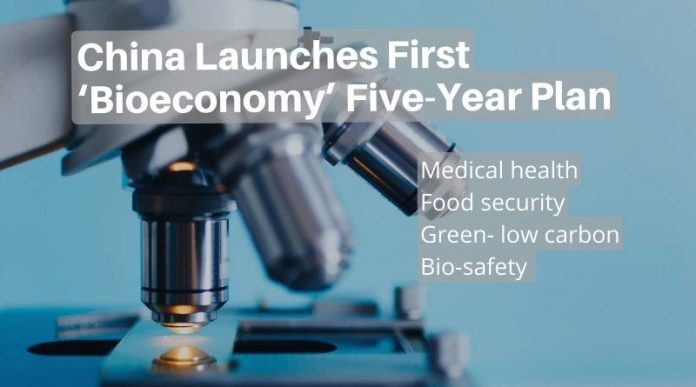China has launched its first five-year plan for the development of the biotechnology economy, vowing to raise the value of the sector to 22 trillion yuan ($3.3 trillion) and nurture more companies with revenues upward of 10 million yuan.
The plan, published by the National Development and Reform Commission (NDRC), aims to grow the contribution of what is dubbed the ‘bioeconomy’ to China’s GDP.
According to the plan the “bioeconomy” is driven by the development and progress of life sciences and biotechnology, based on the protection, development and utilisation of biological resources, and is based on extensive integration of medicine, health, agriculture, forestry, energy, environmental protection, materials as well as other industries.
Why should the “bioeconomy” be planned separately?
On May 10th, Wang Xiang, deputy director of the High Technology Department of the National Development and Reform Commission, explained at a press conference the considerations for releasing the first five-year bioeconomy plan.
Wang said that at present, the development of the bioeconomy and the global bio-tech revolution and industrial transformation are at a major intersection.
As an important part of China’s science and technology economic strategy, the bioeconomy will provide new opportunities for addressing major challenges such as life and health, climate change, resource and energy security, and food security solutions.
Wang Xiang, deputy director of the High Technology Department
What are the four key industries of China’s Bioeconomy Five-Year Plan?
According to Wang, the four key development areas of the bioeconomy are medical health, food security, green and low-carbon and biosafety.
Related: A Biotech Revolution is coming, is the Hainan FTP ready?
The new document, released by the National Development and Reform Commission, said it is important to boost the bioeconomy during the next five years, to help meet the rising domestic demand for healthcare and better lives, foster high-quality economic development, prevent and control biosecurity risks and modernise China’s system and capacity for governance.
NDRC said the new plan is in line with the requirements of the 14th Five-Year Plan, which pledged to promote the integration and innovation of biotechnology and information technology, as well as accelerate the development of biomedicine, biological breeding, biomaterials, bioenergy and other industries to enhance the bioeconomy in both scope and strength.
Under the plan, a model focusing on protecting and using biological resources and integrating medicine, healthcare, agriculture, forestry, energy, environmental protection, materials and other sectors will become a key driving force to boost high-quality development by 2025.
The Hainan FTP and deepening cooperation in bio-economy innovation
The Plan encourages domestic biological scientific research institutions to take the initiative to initiate and participate in international major scientific projects and participate in the protection and utilisation of biological resources, medicine and health, bio-manufacturing and other fields for international rule and standard setting.
Under the plan it is also important to promote innovative drugs, high-end medical devices, genetic testing, products and services such as pharmaceutical research and development services, traditional Chinese medicine, and Internet diagnosis and treatment are encouraged to go global.
Bio-enterprises are encouraged to establish overseas R&D centres, production bases, sales networks and service bodies.
Departments are to accelerate integration into the international market, accelerate the construction of foreign cooperation bio-industrial parks. International cooperation will focus on the field of medical and health care in the Hainan Free Trade Port to explore the development and application of advanced biotherapeutic and diagnostic technologies.
Related article: June 1st! Haikou to give 5 million in subsidies to newly established state-level key laboratories






